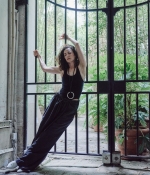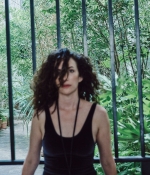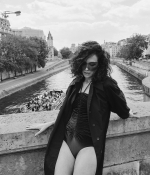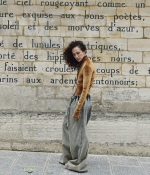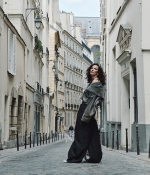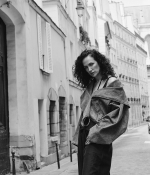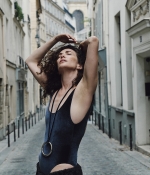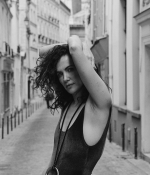Kate Breaks Down her Mysterious ‘Haunting of Bly Manor’ Role

Every ghost has a backstory; it’s maybe the most important thing about them. Netflix’s The Haunting of Bly Manor is loosely based on Henry James’ novella The Turn of the Screw, much as its predecessor The Haunting of Hill House was loosely based on the Shirley Jackson novel of the same name. But that’s not the only James story that the new season is riffing on. Another one, titled “The Romance of Certain Old Clothes,” is the source for both the title and story of episode 8 of Bly Manor, which stands apart from the rest in several ways. Filmed in black-and-white and set centuries before the rest of the season’s episodes, “The Romance of Certain Old Clothes” is essentially an origin story for how Bly Manor first came to be haunted by vengeful ghosts. It stars Hill House alums Kate Siegel and Katie Parker as Viola and Perdita, two rich sisters who end up competing for the love of the same man and killing each other, eventually becoming two of the house’s first specters: The Lady in the Lake and the faceless spirit crawling around the attic, respectively.
Siegel is married to Haunting showrunner Mike Flanagan, and the two frequently collaborate on his film and TV projects. Siegel starred in Hush, Flanagan’s 2016 Netflix horror film about a deaf woman being stalked by a killer in her home, and had a major role in The Haunting of Hill House as Theo Crain. Her role in Bly Manor is more limited but very impactful, so EW caught up with Siegel to discuss filming in black-and-white and the particular resonance of haunted-house stories in a year that so many of us have spent cooped up indoors.
ENTERTAINMENT WEEKLY: It sounds like when The Haunting of Bly Manor was first starting, Mike knew he wanted to bring you and other Hill House actors back, but wasn’t always sure what roles you all would fill. How did your role in this episode come about?
KATE SIEGEL: Mike always knew the second season needed a big standalone episode like season 1’s “Two Storms,” something that shook people out of the narrative and revealed things. As he was telling me about the story of The Turn of the Screw, I’m looking at him going, “there’s no part for me here. I’m not the young naive governess, I’m not the other governess, I’m certainly not Mrs. Gross, so there just isn’t a part here.” This is so ridiculous and I apologize in advance to Mike but I was like, “why can’t you just write me something where I get to wear a bunch of beautiful clothes and lounge around? Because everything I’ve been doing has been running around, my heart’s breaking, my sister’s screaming at me in a car. I just want to wear pretty dresses and be warm.” I’m not saying that’s the reason episode 8 exists, but I’m not saying it’s not!
No, the reality of it is Mike and the writer’s room had cracked this episode. He was waiting for something I would enjoy doing and could excel at. Especially an episode like this, where it’s a bottle episode and you’re gonna see all-new characters, you needed a familiar face right at the beginning of it so fans would stick with the episode. I kind of ground it. Viewers are going to be interested because I’m from season 1 so they know this is something to watch. It’s a bit of a trick to keep people watching episode 8.
I’ve been getting in the mood for Halloween by watching a lot of old black-and-white Universal horror movies this month, and this episode definitely gave me some of that same vibe. How does filming in black-and-white compare to color?
It’s very different, but the performing of it is similar. Both our DP Jimmy Kniest and [episode director] Axelle Carolyn had an extensive knowledge of old black-and-white horror movies, so they worked really hard with the look for that. We were doing a lot of shots on a wide lens but they were close-ups so they were distorted, and so the corners of the room would bend in the frame. It gives it that old creepy feel. I know we talked a lot about the old, old Nosferatu as the monster that Viola becomes. We wanted to reference that a lot, that she becomes this grotesque old Universal monster with the breathing and the grasping. It was definitely on the forefront of all our minds, those classic monsters.
On top of black and white, this episode is also different because it features more of Carla Gugino’s narration than the other episodes. What’s it like acting that out instead of using your own dialogue?
Well luckily I had a lot of experience with that from Hush, which was a movie with almost no dialogue. I learned all about manipulating tiny muscles in your face and how to convey thought as fact on camera, how much is too much, and back and forth. In those moments you really have to rely on your director, your DP, and your scene partners, because you don’t have the benefit of being able to say what you’re feeling. You just have to lean into it. More than I ever have before, I relied on playback. Between takes I would go back and watch what we had shot so I could make sure what I was doing was coming across.
It’s easy to believe that you and Katie Parker are sisters. Mike told us that you guys have actually wanted to play sisters for awhile, is that right?
We always wanted to play sisters! This too comes from weird conversations we have with Mike over dinner: “Why can’t I just wear dresses? Why can’t Katie be my sister?” Things like that. But it was such a dream to have her, because we are that close and we do love each other in that deep familial way. To reach out and die in her arms was a unique experience based on our decades of friendship.
Your role on Bly Manor is obviously very different from your role on Hill House, where you were a main character. How did your experience of making them compare?
It felt like a gift. We shot episode 8 very last, it was the last thing that was shot, because you had to turn the entire house set back in time. The rest of the cast and crew had been through however many months of this Canadian winter so people were understandably drained, and then Katie and I show up with fresh, bouncy energy. It took a second, but we were able to kind of swing things back so the show as a whole ended on a high note, in terms of production. So I really enjoyed it. But I did miss getting to be a part of the whole cast. I’m such a fan of Bly Manor. I’m so impressed by the work they’ve done. Victoria [Pedretti] is a tour de force, and having gotten to know her during Hill House and then not getting to spend time with her during Bly Manor was a real heartbreaker.
It’s especially interesting to watch a haunted-house show in the year of quarantine, when so many of us have been stuck inside. What do you hope people take from it?
I like to think people will identify with Viola more. If I say to you “she sleeps, she wakes, she walks,” you can know what that feels like to be trapped in your house. We’re not trapped in our houses by a decades-old curse, we’re all there because we choose to be like Viola.
In some ways that has been the challenge of quarantine: To stay connected to our loved ones and the world, and not have our faces and personalities melt away like the Bly Manor ghosts.
I also think it’s important right now, because horror helps people process trauma. It’s a safe place to be afraid because you know it ends. This is a particularly excellent show for that. It shows that this type of fading away can be fought through human connection, and love, and it’s important. It will allow people to vent a little bit, and maybe let go of some of this grief and trauma we have from being stuck in our homes.

